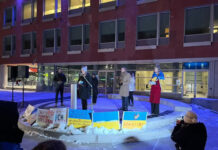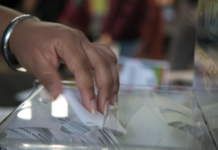by Hannah Tellier
Election season has returned in Waterloo and as per custom, candidates have been hitting the streets in the hopes of putting their best foot forward with constituents.
Competing for the seat of mayor on Oct. 22 will be political newcomer Chris Kloednik, long-standing public servant Kelly Steiss, and incumbent Dave Jaworsky.
On Thursday (Oct. 18), candidates brought their best to the Bomber for a ‘meet-and-greet’ event with students. In preparation for the vote, Imprint took a moment to catch up with them to learn more about the platforms.
Commercial real-estate agent by trade, Chris Kloednik said his mayoral run has been “a year or two in the making”.
“Frankly,” he said, “We just need change at the city level; that’s why I decided to run.”
Having spoken to “thousands” of Waterloo citizens leading up to election, Kloednik said his primary concern surrounds the disconnect between city council and the public.
“They feel that their views at city hall aren’t being currently represented … basically we’ve got to get more people voicing their opinion at the municipal level.”
“I’ve door-knocked in every single ward and that’s the common sentiment — that they’re not listening.”
As a result, said Kloednik, council has come to decisions which he feels are out of touch with the desires of the public.
“The bike counter was $25,000. That’s currently on King St. … that’s a waste of money,” he said. “The other thing was also the streetscape project which was roughly 10 or 11 million dollars. That’s not something I would have voted for, personally.”
In speaking to those who live, work, and own businesses Uptown, Kloednik recalled many having expressed their disapproval of these projects, especially with ongoing disruptions due to construction associated with the LRT.
“They told me directly that they weren’t listened to,” he said.
Engagement with the public and the listening which accompanies it, said Kloednik, “can start right away.”
Should he be elected into office, Kloednik said he hopes to maximize the use of town halls, suggestion boxes, and the city council website as forums for the public to voice their concerns.
When asked to reflect on issues relevant to students, Kloednik addressed taxation, a keystone of his campaign and something which the municipal maverick feels must be “curbed”.
“I always say taxes,” he said. “When you look at property taxes, all those costs are passed back on to students.”
“Over the last few years we’ve seen our property taxes by over 13%, the highest ever over in one single term of council and it’s almost double from the previous council,” said Kloednik.
With regards to student living, Kloednik hopes to tackle issues of property management head on.
“One thing that I want to do is scrap the rental by-law or modify it completely. These costs add, on average, about $100 a month to the average student population and tenant population of Waterloo.”
Closing out his remarks, Kloednik expressed his confidence in that campaign efforts have been enough to engage the Laurier and University of Waterloo populations.
“I think I’ve reached out to students as much as I can,” he said. “Obviously I’ve been trying to engage [them] on the topics they care about.”
On matters of engagement, Kelly Steiss is no stranger. Waterloo alumna and municipal government staff of 16 years, Steiss too hopes to achieve an improved connection between city council and constituents.
Having interacted with students as part of her campaign team, Steiss stated her ambition to create an ongoing relationship with students and the public which is not only active but “innovative”.
“Mayor and council and public servants … really, we can’t be making decisions unless we’ve heard from the people,” she said.
By harnessing local tech talent, Steiss expressed her hope of creating and maintaining “open communication and dialogue with the people of Waterloo.”
Such a dialogue, she said, is especially important to students.
“For me, making sure that we are available and accessible to the students that come to our city is really important because I think sometimes I think our students are often overlooked.”
In terms of current interactions with the demographic as part of her campaign, Steiss elaborated on the concerns on which have surfaced most recently.
“What I’ve heard … is [that] our students want access to reliable housing.”
Citing instances over the past years when students have moved into Waterloo with housing either incomplete or under construction, Steiss emphasized her focus on city council as a structure for enabling change.
“I think that’s horrible that students have come to our city and not had their apartment buildings ready,” she said. “The municipal government can have a role to play in that to hold the developers accountable…”
Such accountability must extend also to city council itself, said Steiss, particularly with regards to taxation.
“We need taxes to make our city run,” she said, “But for me what is really important is that we spend the taxpayer’s money wisely. That’s why I embrace the idea of fiscal responsibility because we need to spend our money in the right ways and on the right things.”
In an example of what she felt showed “struggling” logic in spending on the behalf of mayor and council, Steiss too highlighted the recent aesthetic changes on King St.
“So recently, this mayor and council approved spending $600,000 on lights in the Uptown,” she said. “Now, I know we need to spend money in the Uptown because we need to make it’s vibrant and it’s a place where people want to go. But I don’t know that we needed to go with the $600,000 option…”
What’s most important in decisions like these, said Steiss, is listening to the constituents to address what she described as more pressing concerns in the region.
“We have a significant rat problem emerging in Waterloo,” she said. “People are asking for segregated bike lines. Could we not have got away with spending less money on those lights and reallocating some of that money to better uses within our city?”
Citing her “breadth and depth” of experience working for municipal government, Steiss explained that her main goal as mayor would be to transform Waterloo into a city where students would not only desire to stay but more importantly, can stay following graduation.
“Right now, we’re seeing our students’ wonderful talent and knowledge move into cities like Kitchener and Cambridge because it’s more affordable. And Waterloo’s a great city to stay in and so I want to make sure that we address things like making sure that housing options are affordable for students, making sure that we have a diversity of economy and that we embrace the diversity that our student community brings…”
Wrapping up her comments, Steiss too expressed her confidence to be able to serve Waterloo.
“I have a good sense on how the city runs,” she said, “And that’s why I have such confidence about my ability to serve as mayor.”
Current mayor Dave Jaworsky, who shares a similar sentiment to Steiss, was candid on the topic of his campaign.
“It’s tough being both a seven day a week mayor and a seven day a week campaigner and trying to find some … time to sleep,” he laughed.
Among his platform priorities were a number of hot-topic items which built primarily upon the progress of his past term, development in particular.
Explaining the neighbourhood strategy initiative — a two-year study involving over 100 participants — the incumbent elaborated on the direction in which he hopes the neighbourhoods of Waterloo could grow under his continued leadership.
“I often tell people that cities grow out and then up, and people grow up and then out,” he laughed.
“We’re not only talking about horizontal neighbourhoods like the subdivision but let’s talk about vertical neighbourhoods like the towers — and a lot of students live in towers.”
As part of the initiative, he said, “The citizens came up with a plan of about 25 different items rolling out over a period over five years and some were so unique we said why wait a few months for the next term of council?”
Notable among these was a micro-grant program whereby funds from council could be dedicated to neighbourhood improvement projects. Launched only weeks ago, the grants measure in the range of a few hundred dollars, pre-approved to enable ideas which Jaworsky said are hindered only by lack of funds.
“The reality is… our neighbourhoods is where everything happens,” he said. “So let’s empower the neighbours to do good things on their own streets.”
According to Jaworsky though, the nature of neighbourhoods is changing altogether. The city of Waterloo having approved it’s “last ever” subdivision, he noted instead the goal of intensification, particularly along the path of the LRT.
“What if it was actually vibrant? What if it had music? What if it had places to live?,” he asked.
Of particular importance to these plans, he said, are intentions for parks and the improvement of existing trail systems.
“That’s what we’re really trying to do is make these places much more walkable locations as opposed to drivable locations,” said Jaworsky.
His platform approach? Innovation and intensification, such as the kind which made Waterloo the first city in Canada to implement the Lime e-Scooters.
“It’s a very small city geographically so we must look for new ideas,” said Jaworsky.
In addition to innovation, Jaworsky also noted the opportunity to improve upon existing infrastructure, highlighting in particular his ideal of the “super trail” to connect currently fragmented trail systems.
Complementary to these would be additional, multi-use trail lines and formalized bike lanes.
On funding projects of this nature, Jaworsky briefly addressed the spending of city council, the likes of which had been so drawn into question the campaigns of his peers.
“So far in … my first term of council, we had budgets that were targeted at inflation and we mostly achieved that,” he said.
Efficiencies have been especially important, he said and noted especially the installation of LED lighting in city buildings and streetlights, saving taxpayers a combined $880,000 per year in utility costs.
In addition to saving money at home, Jaworsky emphasized the importance of grant money from higher levels of government.
“Most people don’t realize that cities only have two forms of fundraising and that is property taxes and user fees,” he said.
“People always think we get a slice of the income tax [and] no that is not true”
Neither does is apply to HST, he said. As such, grants of this nature help to divert cost from taxpayers.
“So it’s a multi-point plan of growth, low taxes, grants, and efficiencies that bring it all together.”
Jaworsky, UW alumni of math and computer science, feels his connection to students has remained strong.
“After becoming mayor, I have [had] regular meetings with the Federation of Students, regular meetings with the Laurier Student Union and we work on problems together,” he said.
Should he be re-elected to the seat, Jaworsky highlighted the continued work which he hopes will benefit students. Primary among these, an inclusionary zoning study in cooperation with the city of Kitchener whereby the construction of high-rise towers could be required to include affordable units for lower income residents — namely, students.
Equipped with 25 years of business experience, Jaworsky expressed his hope to continue to serve the city.
“It’s that type of experience that I can now use as background information,” he said.
Voting takes place Oct. 22. More information on the candidates’ platforms can be found at their respective websites.































